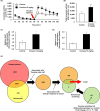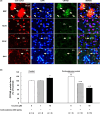Crystallin Alpha B Inhibits Cocaine-Induced Conditioned Place Preference via the Modulation of Dopaminergic Neurotransmission
- PMID: 40095747
- PMCID: PMC11912016
- DOI: 10.1111/adb.70028
Crystallin Alpha B Inhibits Cocaine-Induced Conditioned Place Preference via the Modulation of Dopaminergic Neurotransmission
Abstract
Nonneuronal cells mediate neurotransmission and drug addiction. However, the role of oligodendrocytes in stress-induced cocaine relapses remains unclear. In the present study, we investigated the role of the oligodendrocyte-abundant molecule crystallin alpha B (CRYAB) in cocaine-induced conditioned place preference (CPP) relapsed by restraint stress. RNA sequencing (RNA-seq) was performed to identify oligodendrocytes and stress-associated molecules in the nucleus accumbens (NAcc) of both drug users and cocaine-treated animals. Further, we studied which cell subtypes in the brain express CRYAB. The effects of stress hormones and cocaine on CRYAB expression were evaluated in vitro in human oligodendrocytes. CRYAB is upregulated in the NAcc of both cocaine-treated animals and drug users. CRYAB levels in the NAcc of mice increased during CPP development but decreased following stress-induced relapse. Interestingly, CRYAB is expressed in oligodendrocytes in the NAcc of mice. Extracellular CRYAB levels are regulated by cocaine and stress hormone treatments in oligodendrocyte cultures. Dopamine levels in the NAcc and CPP development of CPP are significantly increased by cocaine in CRYAB knockout (KO) mice. Further, we demonstrated that CRYAB binds to the excitatory amino acid transporter 2 (EAAT2) in the NAcc of mice treated with cocaine. We suggest that oligodendrocyte-derived CRYAB regulates dopamine neurotransmission and stress-evoked cocaine reward behaviour via the modulation of EAAT2 in the NAcc.
Keywords: cocaine relapse; crystallin alpha B; drug addiction; excitatory amino acid transporter 2; nucleus accumbens; oligodendrocytes.
© 2025 The Author(s). Addiction Biology published by John Wiley & Sons Ltd on behalf of Society for the Study of Addiction.
Conflict of interest statement
The authors declare no conflicts of interest.
Figures






References
-
- Hayley S., Merali Z., and Anisman H., “Stress and Cytokine‐Elicited Neuroendocrine and Neurotransmitter Sensitization: Implications for Depressive Illness,” Stress 6, no. 1 (2003): 19–32. - PubMed
-
- Jha S. K., Jha N. K., Kumar D., et al., “Stress‐Induced Synaptic Dysfunction and Neurotransmitter Release in Alzheimer's Disease: Can Neurotransmitters and Neuromodulators Be Potential Therapeutic Targets?,” Journal of Alzheimer's Disease 57, no. 4 (2017): 1017–1039. - PubMed
-
- Carelli R. M., “The Nucleus Accumbens and Reward: Neurophysiological Investigations in Behaving Animals,” Behavioral and Cognitive Neuroscience Reviews 1, no. 4 (2002): 281–296. - PubMed
MeSH terms
Substances
Grants and funding
LinkOut - more resources
Full Text Sources
Medical
Research Materials

